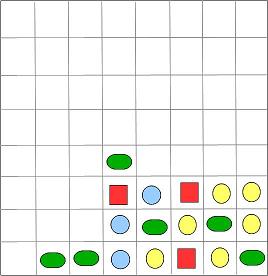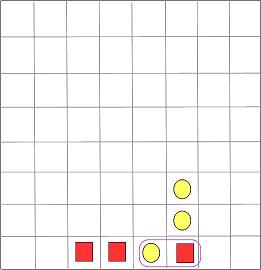The Wiki for Tale 6 is in read-only mode and is available for archival and reference purposes only. Please visit the current Tale 11 Wiki in the meantime.
If you have any issues with this Wiki, please post in #wiki-editing on Discord or contact Brad in-game.
Test of Gemology
Summary
This game has a designed layout of different colored/shaped gems laid out on an inclined board. The player of the puzzle makes moves by picking two adjacent jewels to swap positions. When a linear match of 3 or more of the same jewel type is formed, the matched set is removed from the board and the remaining pieces slide vertically down into the gaps. The object of the game is “sort through all the jewels” by making matches and clearing the board completely.
Setup
The player building the puzzle needs to build a game board, called the “Sorting Table”. It would be built inside a CP, and have an angle to it, so the pieces can be understood to slide downwards. It should be fairly large, so the installed gemstones can be seen clearly on it. It will have an inherent grid on it that the player will set gems into. Suggested size of the grid is at least 8x8 slots.
After a player has built the table, they can choose to edit the design. In this mode, they can toggle each space to have a different colored gem, or no gem at all. Not all spaces on the board have to be filled, but there should be no spaces under gems (which would violate gravity). Once they have a gem setup they like, they can choose a mode “solve as designer” (much like a venery has). This is very important because most random color assignments will not have valid solutions!! A designer needs to first validate the existence of a solution to their initial conditions.(see note 1 below). There should be a “reset” option in the menu to set the pieces back to what the player designed, as most puzzles will take players multiple attempts to solve. At any point, the designer may re-enter the “edit” mode, and adjust the initial gem board. In Edit mode, there is a menu option to set the number of swaps allowed. When the designer successfully solves the puzzle, this number of moves they took is set as the default number of moves allowed. (However, they can manually set this number higher if they choose to). Once the designer has found a solution, they will then be able to choose to “open the test” to the public. (If they solve it, and re-enter the “edit” mode, this option to open the test will disappear until the puzzle is re-solved.)
After the Puzzle is open, players can walk up and choose to play. They make moves by toggling a selection highlight over gems. They pick one gem, and can either unselect it, or select an adjacent gem. When two adjacent gems are highlighted, their positions swap. Gems cannot be swapped with empty spaces. If a set of 3 or more matching jewels (in a straight line) is made, those gems are removed from the board, and the pieces slide vertically down, filling in any gaps that were created. Then the player makes another move, etc. At any point, they can click on the table to choose to “reset” it. When they solve it by clearing the sorting table, they will get a pop-up message that they were successful, and be given the option to judge it. At that time, the table will reset as well.
Passing the Test: Like other Thought Tests, the designer will accumulate a score based on the judgments of successful players. Each week, the two highest scores will pass the Test. The reward for passing this test is that three times a day, a player can remove a cutable gem from the cutting table before its been cut (hence, resetting the voids).
Examples
- This is an example of an invalid design. The green gems on the right have nothing underneath them!! In addition, the blue gems have no way to be matched.

- This is an example of a proper design. It is solvable in 5 moves (2 of which are only swaps, 3 of which make sets).

Construction Cost Suggestion
- 14 Medium Diamonds
- 14 Medium Emeralds
- 14 Medium Opals
- 14 Medium Quartz
- 14 Medium Rubies
- 14 Medium Sapphires
- 14 Medium Topaz
- 100 boards
- 200 bricks
- (mats are meant to be easy to obtain early in the tale)
Further Points
Note 1
This test is different than many other Thought tests because of how the player approaches designing the puzzle. Other tests, like Bijou, Constellation, Pathmaker, and Hexaglyphs, have a player first construct a solution. They don’t experience how the flow of the puzzle is for another player when they reverse engineer like this. Therefore, these tests can easily have solutions that are arbitrarily hard, because a player just hit a lot of random selections which are difficult to replicate. Furthermore, with inherent knowledge of the solution, the designer can’t genuinely gauge the challenge level of their puzzle. For these reasons, these tests can be hard to tune to a desired level of difficulty.
For the Test of Gemology, the designer must think like a player doing the puzzle. They can still choose to make it very hard or very simple, but by having to go through the same pathway as the player (thinking through it from start to finish), it will be easier to gauge the player experience of it, and therefore tune the level of difficult to what they want. At least, that is my hope.
Note 2
This test is also meant to be quick to attempt for players. (There are already many puzzles that involve significant time commitment to solve. This is meant to balance that).
